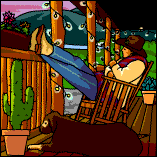The Truth about the Wild West
Created | Updated Feb 23, 2005

Imagine, if you will, the following scene:
Two men in cowboy hats face each other across a dusty street. They squint in the hot sun, each waiting for the other to move first. Hands twitch, edging closer to holstered six-shooters. Finally, in a blur of motion, both men draw and fire at almost exactly the same instant. Almost. One man falls, while the other holsters his weapon in some suitably extravagant manner, perhaps spinning the gun by its trigger guard or blowing smoke from the end of the barrel.
The Wild West
When one hears the phrase 'Wild West', this scene, or a similar one, probably springs to mind. Of course, this notion of the shoot-out at high noon is utterly false, and deep down, those who romanticise the American west of the late 1800s know that. There are, in reality, three things that define the 'Wild West', and these things are:
The portion of America that most people define as the 'Old West', roughly the area between the Mississippi River and the Rocky Mountains, is for the most part a dreary, inhospitable place. The inconsistent winters arrive without any warning and rarely last long enough to offer any relief from the dry, hot haze that is spring, summer and autumn. When the first American explorers surveyed the area, they labelled it 'the Great American Desert' on their maps, they declared the whole place uninhabitable. The Indians and buffalo were welcome to it.
The Gold Rush
That is, until some idiot coined the phrase 'there's gold in them thar hills!'. Before it was discovered that there were spotty supplies of gold and silver scattered throughout the region, no one other than a handful of stubborn farmers and sadistic buffalo hunters wanted anything to do with the place. But the promise of easy money lured thousands of would be miners and millions of gamblers, prostitutes, con artists and others who figured they could make more money from the mining boom than those who actually did the mining. Not only were they right, but they established the principle that modern America is based on.
So, into this environment (that had been judged inhospitable before anyone knew about the gold) came millions of barely educated people, armed to the teeth and with nothing more rewarding to do with their free time than drink themselves into an incomprehensible stupor and let the heat burn away their last remnants of temper and self-control.
The Reality
The 'Wild West' that is shown in Western movies only occurred on the edge of society, as the gunmen raced away from the law to areas where law enforcement - and the law - struggled to catch up. In total, it only lasted for 15 years or so. In short, the West was wild because everyone in it was drunk and had a gun. This is probably a more accurate description of the average 'Wild West' gunfight:
The unrelenting sun beat down on the dry, dust-filled street as two men drunkenly staggered from the saloon. One held a rusty pistol in his outstretched hand, while the other clutched his bleeding ear and struggled to remove his own gun from its holster. The first man fired his gun repeatedly. Most of the shots went wide, but one bullet managed to hit its target, who collapsed bleeding in the dust. The winner's victory was short-lived, however, as he was soon clubbed down from behind by the local sheriff...

